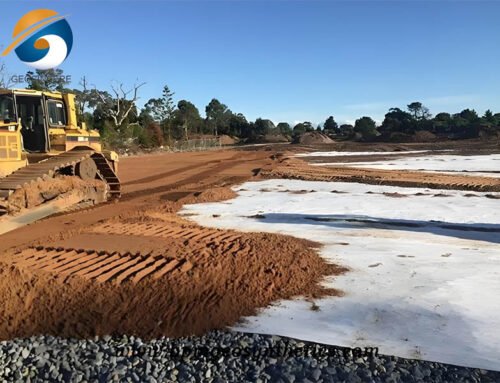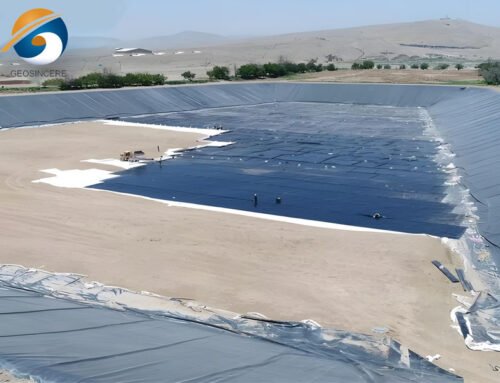Landscape fabric is also called garden fabric, weed fabric or landscape fabric. Landscape fabric is made of woven or non-woven fibers. The solid sheet has perforations that allow water and air to penetrate.Landscape fabric is a weed control mechanism. So, if you are really tired of weed invasion in your garden, landscape fabric will help you control it. In this article, we will discuss woven and non-woven landscape fabrics and how to choose the best one.GEOSINCERE is the leading geosynthetics manufacturer and supplier, in this article we will delve into the differences of woven vs non woven landscape fabric, exploring their materials, types and functions.
1. What Is Woven Landscape Fabric?
Woven landscape fabric is a durable and permeable material used in landscaping to control weed growth and protect the soil. It forms a barrier against weeds while allowing water to drain through. The fabric is made from woven polypropylene or polyethylene fibers and is resistant to UV radiation and degradation. It is easy to install and commonly used in garden beds, pathways, and other landscaped areas to maintain plant health and a tidy appearance.In some cases, such as in vegetable gardens or areas with aggressive spreading plants, alternative weed control methods may be more appropriate. Consulting with a landscaping professional or horticulturist can help determine the best approach for specific gardening or landscaping needs.
2. What Is Non Woven Landscape Fabric?
Non-woven landscape fabric is a durable material used in landscaping to suppress weed growth and protect the soil. The fabric is made from synthetic fibers, is easy to install, and provides soil stability and plant health. Non-woven landscape fabric offers effective weed control and soil protection while allowing for proper water drainage. Its durability, ease of installation, and versatility make it a popular choice for maintaining healthy and visually appealing landscapes.


3. What Is Difference of Woven vs Non Woven Landscape Fabric?
The primary difference between woven and non-woven landscape fabric lies in their construction and the way they control weed growth. Here are the key distinctions:
3.1 Woven Landscape Fabric
3.11 Construction
Woven landscape fabric is created by weaving polypropylene or polyethylene fibers together, forming a tightly woven structure.
3.12 Weed Contro
Woven fabric acts as a physical barrier that blocks sunlight, preventing weed seeds from germinating and growing.
3.13 Water Permeability
Woven fabric allows water to pass through the gaps between the woven fibers, ensuring proper drainage.
3.14 Durability
Woven fabric is highly durable and can withstand heavy loads and foot traffic.
3.15 Soil Protection
Woven fabric provides effective soil stabilization and erosion control.
3.16 Applications
Woven landscape fabric is commonly used in areas with high foot traffic or where heavy loads are expected, such as driveways or pathways.
3.2 Non-Woven Landscape Fabric
3.21 Construction
Non-woven landscape fabric is made by bonding or felting synthetic fibers together, creating a sheet-like structure without weaving.
3.22 Weed Control
Non-woven fabric forms a physical barrier that blocks sunlight and prevents weed growth.
3.23 Water Permeability
Non-woven fabric allows water to permeate through its porous structure, facilitating proper drainage.
3.24 Durability
Non-woven fabric is less durable than woven fabric but still offers sufficient strength for most landscaping applications.
3.25 Soil Protection
Non-woven fabric helps prevent soil erosion and provides some degree of stabilization.
3.26 Applications
Non-woven landscape fabric is commonly used in garden beds, flower beds, and other areas where weed control and soil protection are desired.


4. How To Choosing Right Woven vs Non Woven Landscape Fabric?
When choosing between woven and non-woven landscape fabric, consider the following factors to determine which type is best suited for your specific needs:
4.1 Weed Control Requirements
Both woven and non-woven fabrics offer effective weed control, but woven fabric provides a more reliable barrier due to its tightly woven structure. If you are dealing with aggressive or persistent weeds, or if weed control is a top priority, woven fabric may be the better choice.
4.2 Water Drainage
Both types of fabric allow water to permeate through, but woven fabric typically offers better drainage due to its open weave pattern. If you are concerned about excessive water retention in your soil or dealing with areas prone to waterlogging, woven fabric may be more suitable.
4.3 Durability and Strength
Woven landscape fabric is generally more durable and better suited for heavy-duty applications or areas with high foot traffic. If you anticipate heavy loads or frequent foot traffic, such as in driveways or pathways, woven fabric is a more robust option. Non-woven fabric is still durable but is better suited for lighter-duty applications.
4.4 Soil Stabilization and Erosion Control
Both woven and non-woven fabrics provide some degree of soil stabilization and erosion control. However, woven fabric’s tightly woven structure offers better soil stability and is more effective in preventing soil erosion. If your project involves slopes or areas prone to erosion, woven fabric is the recommended choice.
4.5 Application Specifics
Consider the specific requirements of your landscaping project. Evaluate factors such as the type of area (garden bed, pathway, driveway), anticipated foot traffic, expected loads, and the types of weeds you are dealing with. This will help you determine which fabric type is better suited for your unique situation.
5. Summary
Woven landscape fabric is characterized by its tightly woven structure, high durability, and suitability for heavy-duty applications. Non-woven landscape fabric, on the other hand, is created by bonding fibers together and offers effective weed control and soil protection in lighter-duty landscaping projects. The choice between woven and non-woven fabric depends on the specific requirements of the project, including expected loads, foot traffic, and desired weed control effectiveness.
GEOSINCERE brand geosynthetics products and solutions can meet your requirements by our solid technologies, innovative engineering solutions and excellent customer services. Any questions or inquiries, please contact us.





